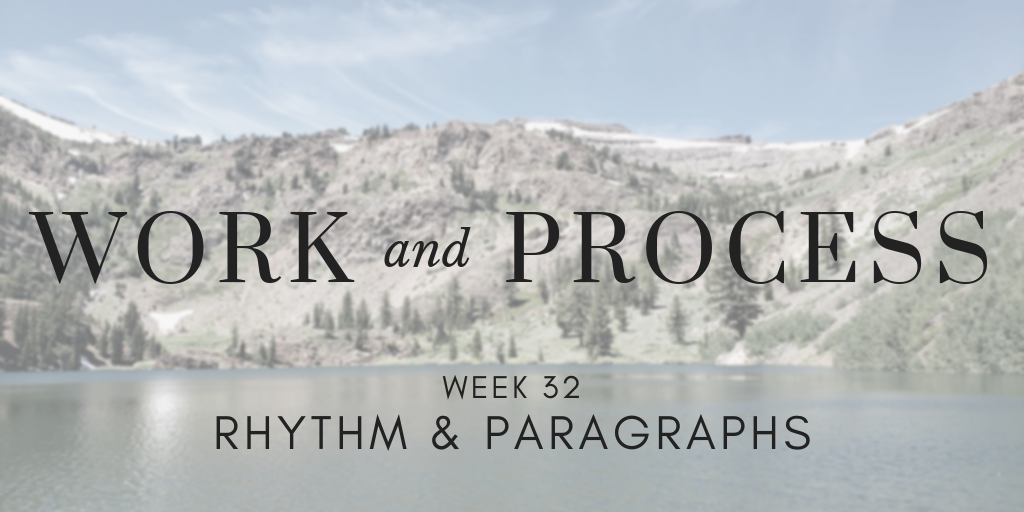|
Last week, I wrapped up copy edits on my secret project (which I can announce next Tuesday--check in with me on Twitter, Instagram, and Facebook to see my behind-the-scenes #bookfacts countdown!), which means that I’ve just come off reading my entire book aloud for the first (and also last) time. I always do this during copy edits, read each word from beginning to end. It’s more time-consuming, to be sure, but it’s also a necessary step for me. First, reading aloud makes it easier for me to catch technical issues like typos and repeated words. Second, it allows me to hear (and feel) the rhythm of a story, from the plot beats, to the dialogue, to the way sentences flow in and out of one another, to the meter of a phrase or even a single word. Rhythm, according to literarydevices.net, is all about stressed and unstressed syllables, which is a rather simple way of looking at this very interesting writing tool. Rhythm, for me, is like pacing. Does the story feel fast or slow? Do the sentences feel frenetic or leisurely? Is the energy of a scene high energy or low? Are the sentences getting the breathing room they need, the room for a thought to ring out before the reader moves on? Or, conversely, are they running together, jostling for space, when the story needs to be urgent and breathless? All of these questions for me are answered with rhythm, which I think operates at various levels of the writing:
For this week, let’s take rhythm at the level of the paragraph. I think there are two main considerations here: length and white space. With regards to length, in general, longer paragraphs will feel slower. Since, also in general, each paragraph focuses on one topic/character/idea/action, the more words that we devote to that topic/character/idea/action, the more time we spend lingering on it. Shorter paragraphs, then, will feel faster, like our attention flits briefly to something and then away again just as quickly. When it comes to white space, the amount of the blank page we see around a paragraph will also affect how much we focus on it and therefore how weighty or important it feels. For example, if a single word is its own paragraph, surrounded by emptiness, it feels more important, like if it deserves its own line, then it deserves to be given more thought/attention/respect/consideration. In contrast, if a single word is buried in a much larger paragraph, well, then, that single word just kind of blends in with everything else, it’s importance tied more to the words around it than to the word itself. As a case study, I’d like to take a look at passages from the first two chapters of Renée Ahdieh’s YA fantasy, Flame in the Mist, where she varies her paragraph length to create the rhythm of a scene. Here, the main character, Mariko, is in a carriage with a contingent of soldiers to guard her from the dangers of the road and the forest they’re passing through. The gathering of shadows shifted outside, growing closer and tighter. Mariko’s convoy was now deep beneath a canopy of trees. Deep beneath their cloak of sighing branches and whispering leaves. Strange that she heard no signs of life outside—not the caw of a raven nor the cry of an owl nor the chirr of an insect. The first paragraph is longer, four complete sentences, and it lingers on the details of the forest: the encroaching shadows, the darkness and density of the woods, the eerie absence of the sounds of nature. The length of the paragraph here emphasizes the looming feeling of the forest they’re entering, and the amount of space it takes up means that it literally dwarfs the next two paragraphs, which are half as short and centered on Mariko’s convoy. There, the emphasis is on the action (the norimono halting; the horses panting and stamping), and because the paragraphs are so short, these things feel more important, more powerful, and more tense, like there’s a lot more riding on them than the longer description of the forest above. The next chapter, too, begins with short paragraphs, as Mariko wakes from being knocked unconscious in her litter. Mariko woke to the smell of smoke. To a dull roar in her ears. There’s this quick, almost disorienting rhythm to the paragraphs here, as Mariko regains consciousness. I think perhaps her body understands the danger before she herself can grasp it, because there’s no time for processing in these paragraphs, just: smoke, roar, pain. Because of the length of the paragraphs, these sensations hit us quickly, and because they stand on their own, they also hit us hard. It isn’t until paragraph four that Mariko, I think, realizes what’s happened, and she focuses on the body of her maidservant, Chiyo. Mariko takes the time (and page space) to both acknowledge the dead body and to remember the person Chiyo was in life (“loved to eat iced persimmons and arrange moonflowers in her hair”). The length of this paragraph slows down the scene, here, giving both Mariko and us, the readers, time process what’s happened. But also note the last paragraph: “The same eyes that were now frozen in Death’s final mask.” This technically could have been a part of the longer paragraph because it’s still technically about Chiyo, but here, Ahdieh is giving more weight, in the form of white space, to this single thought: Chiyo is dead. Chiyo is dead forever. Here, we’re no longer lingering over fond memories. We are literally being stomped back into reality. Chiyo is dead. Mariko is in danger. And in the next two paragraphs, the scene picks up the pace again as Mariko begins to assess her surroundings with more clarity. I’d also like to note that paragraph lengths can also act like meter. Two paragraphs of similar length, for example, will feel more even, or balanced, or solid, or plodding, like a spondee (two stressed beats). In our second passage above, “The same eyes that were now frozen in Death’s final mask.” and “Mariko’s throat burned. Her sight blurred with tears.” are of similar lengths, so it feels like they have the same weight: the single image of Chiyo’s dead eyes and Mariko’s grief for her. These things, the paragraph lengths tell us, feel the same in importance. Short-short-long paragraphs can feel like anapests, that kind of driving/galloping/rollicking rhythm, the short paragraphs propelling the reader into the longer ones. Again and again, I think we’ll end up seeing rhythm operating like this across all these different levels of text--come back in the following weeks as we explore sentences, diction, and punctuation, too! Comments are closed.
|
ARCHIVES
February 2024
CATEGORIES |


 RSS Feed
RSS Feed